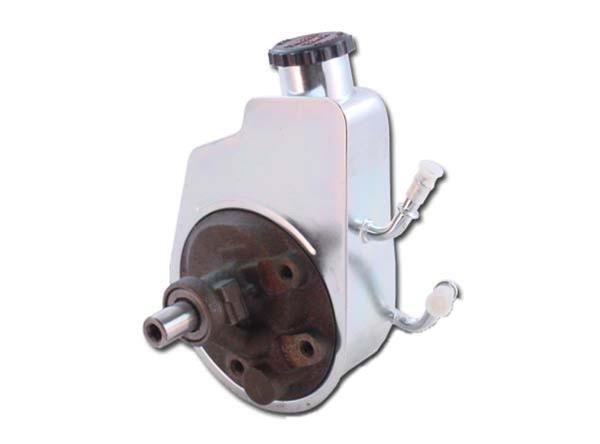Hydroboost power steering problems often stem from fluid leaks, a failing pump, or air in the system. These issues can lead to reduced steering response and increased effort when turning the wheel.
Hydroboost systems use hydraulic pressure from the brake system to assist steering. Many drivers appreciate this setup for its efficiency and space-saving design. However, like any mechanical system, hydroboost can develop issues over time. Common problems include leaks, noisy operation, and a stiff steering feel.
Addressing these problems promptly is crucial for maintaining vehicle safety and performance. Regular maintenance checks can help identify potential issues early. Understanding the symptoms can empower drivers to take action before they escalate, ensuring a smoother driving experience.
Credit: classicbroncos.com
Introduction To Hydroboost Power Steering
Hydroboost power steering systems use hydraulic pressure for steering assistance. They rely on hydraulic fluid from the brake system. This technology enhances steering performance in vehicles. Understanding hydroboost systems helps identify potential issues early.
The Basics Of Hydroboost Systems
Hydroboost systems combine brake and steering functions. They operate using hydraulic fluid, providing strong steering support.
- Components:
- Hydroboost unit
- Hydraulic fluid reservoir
- Power steering pump
- Working Principle:
Hydraulic pressure from the brakes assists in steering. This allows for lighter steering effort and quicker response.
- Advantages:
- Improved steering feel
- Better braking performance
- Less engine load
Common Signs Of Hydroboost Failure
Recognizing hydroboost failure can prevent bigger problems. Here are common signs to watch for:
- Steering Difficulty: Hard to turn the steering wheel.
- Brake Warning Light: Light illuminates on the dashboard.
- Fluid Leaks: Noticeable hydraulic fluid under the vehicle.
- Unusual Noises: Hissing or whining sounds while steering.
If you experience any of these signs, inspect the hydroboost system. Early detection can save time and money.
Leakage Issues And Resolutions
Hydroboost power steering systems can face serious leakage problems. These leaks can affect steering performance. Recognizing and fixing these leaks is crucial for safety and vehicle control. Below, we explore how to identify leaks and effective sealing techniques.
Identifying The Source Of Leaks
Finding the source of a leak is essential. Here are steps to help locate it:
- Check fluid levels regularly. Low fluid indicates a leak.
- Inspect hoses for cracks or wear. Look for damp spots.
- Examine the hydroboost unit. Look for fluid pooling underneath.
- Check connections. Tighten any loose fittings.
Use a flashlight to spot small leaks. Look for signs of fluid stains on the ground. Common fluids include:
- Power steering fluid (usually red or clear)
- Brake fluid (usually yellow or brown)
Effective Sealing Techniques
Sealing leaks effectively can restore power steering function. Use these techniques:
| Technique | Description |
|---|---|
| Replace Damaged Hoses | Install new hoses if old ones are cracked. |
| Use RTV Sealant | Apply RTV sealant on connections to prevent leaks. |
| Tighten Connections | Ensure all fittings are tight and secure. |
| Regular Maintenance | Check for wear and tear regularly. |
These techniques can help keep your hydroboost system leak-free. Regular checks can avoid bigger problems later.
Addressing Noise Concerns
Noise from your Hydroboost power steering can be frustrating. Identifying the source is crucial. Knowing how to fix it can save time and money. Let’s explore how to diagnose and solve these noise issues.
Diagnosing The Cause Of Noises
Strange sounds from the steering system can indicate problems. Common noises include:
- Hissing: Often linked to air in the system.
- Grinding: Usually a sign of worn components.
- Whining: Indicates low fluid levels or pump issues.
To diagnose the noise:
- Check the power steering fluid level.
- Inspect hoses for leaks or cracks.
- Listen closely while turning the steering wheel.
Use a mechanic’s stethoscope for precise sound location. Document any patterns in noise occurrence.
Solutions To Silence The System
After diagnosing the noise, apply these solutions:
| Noise Type | Possible Solution |
|---|---|
| Hissing | Bleed the system to remove trapped air. |
| Grinding | Replace worn components like the pump or gears. |
| Whining | Refill fluid or replace the power steering pump. |
Follow these steps to ensure a quiet and smooth steering experience:
- Regularly check fluid levels.
- Replace worn hoses immediately.
- Consult a professional for persistent issues.
Taking action quickly can prevent further damage and noise.
Hard Pedal Troubleshooting
Experiencing a hard brake pedal can be frustrating. This issue often stems from the Hydroboost power steering system. Understanding the reasons behind this problem helps in effective troubleshooting.
Reasons Behind A Hard Brake Pedal
A hard brake pedal indicates a lack of proper brake assist. Several factors can cause this issue:
- Low Hydraulic Fluid: Insufficient fluid affects brake performance.
- Faulty Hydroboost Unit: A damaged unit can lead to hard braking.
- Leaking Hoses: Any leaks reduce hydraulic pressure.
- Blocked Lines: Obstructions can hinder fluid flow.
- Malfunctioning Brake Booster: A failing brake booster impacts braking efficiency.
Easing The Pedal Pressure
Addressing a hard brake pedal involves several troubleshooting steps:
- Check the hydraulic fluid level.
- Inspect for any leaks in hoses and connections.
- Test the Hydroboost unit for functionality.
- Examine brake lines for blockages.
- Consider replacing the brake booster if necessary.
Performing these checks can help restore normal pedal pressure. Regular maintenance ensures your Hydroboost system remains in good condition.
Improving Steering Response
Good steering response is vital for safe driving. A well-functioning Hydroboost power steering system enhances maneuverability. Let’s explore ways to improve steering response.
Adjusting For Better Maneuverability
Fine-tuning your steering system can greatly enhance control. Here are some adjustments to consider:
- Align Your Wheels: Misalignment affects steering. Regular alignment checks are crucial.
- Check Tire Pressure: Properly inflated tires improve grip. Maintain recommended PSI.
- Upgrade Steering Components: Consider performance parts. They may provide better feedback and control.
Fluid Replacement And Its Effects
Fluids play a key role in steering performance. Regular fluid replacement can boost response time.
| Fluid Type | Recommended Interval | Effect on Steering |
|---|---|---|
| Power Steering Fluid | Every 30,000 miles | Smoother operation |
| Hydraulic Fluid | Every 50,000 miles | Improved responsiveness |
Using the correct fluid type is essential. Always follow the manufacturer’s guidelines.

Credit: www.pscmotorsports.com
Boosting System Pressure
The hydroboost power steering system relies on hydraulic pressure for optimal performance. Low pressure can lead to steering difficulties and decreased responsiveness. Understanding how to boost this pressure is essential for maintaining a smooth driving experience.
Methods To Increase Hydraulic Pressure
- Check Fluid Levels: Ensure the hydraulic fluid is at the correct level.
- Inspect Hoses: Look for any leaks or damages in the hoses.
- Replace Filters: Dirty filters can restrict fluid flow. Replace them regularly.
- Adjust the Pressure Relief Valve: This valve can limit pressure. Adjust it carefully.
- Upgrade the Pump: A higher capacity pump can increase overall pressure.
Safety Measures When Adjusting Pressure
Adjusting hydraulic pressure requires caution. Follow these safety tips:
- Always wear safety goggles and gloves.
- Work in a well-ventilated area.
- Disconnect the battery to prevent accidental starts.
- Use proper tools designed for hydraulic systems.
- Follow the vehicle’s manual for specific guidelines.
Taking these precautions can prevent injuries and damage. Always prioritize safety first.
Routine Maintenance Tips
Keeping your Hydroboost power steering system in top shape requires regular care. Routine maintenance helps prevent issues and extends the lifespan of your system. Here are some effective tips to keep your power steering functioning smoothly.
Scheduled Checks For Longevity
Regular inspections can help catch problems early. Follow these scheduled checks:
| Check | Frequency | Notes |
|---|---|---|
| Fluid Level | Monthly | Ensure proper fluid levels to avoid overheating. |
| Fluid Condition | Every 6 months | Look for discoloration or debris in the fluid. |
| Hoses and Fittings | Quarterly | Check for leaks or wear in hoses. |
| Steering Response | Monthly | Assess how the steering feels during use. |
Diy Maintenance Guide
Taking care of your Hydroboost system can be simple. Follow this DIY guide:
- Inspect Fluid Level: Open the hood. Locate the reservoir. Ensure fluid is at the proper level.
- Check Fluid Condition: Use a clean cloth. Wipe the dipstick. Look for any dark or gritty fluid.
- Examine Hoses: Check for cracks or leaks. Replace any damaged hoses immediately.
- Monitor Steering Feel: Drive your vehicle. Notice any unusual sounds or resistance.
- Flush System: Every 2 years, replace old fluid. This helps maintain performance.
Following these tips keeps your Hydroboost power steering in great shape. Regular maintenance saves time and money on costly repairs.

Credit: www.borgeson.com
Professional Help Vs. Diy Fixes
Deciding between professional help and DIY fixes for Hydroboost power steering problems is crucial. Each option has its pros and cons. Understanding when to seek expert assistance or tackle repairs yourself can save time and money.
When To Seek Professional Assistance
Some situations demand professional expertise. Consider these indicators:
- Complex Issues: If the problem seems complicated, consult a professional.
- Safety Concerns: Power steering affects vehicle control. Don’t risk safety.
- Warranty Coverage: Repairs may void warranties. Check before proceeding.
- Lack of Tools: Some repairs require special tools. Professionals have them.
Recognizing these signs can prevent further damage. Take action promptly for best results.
Guidelines For Self-repair
DIY repairs can be rewarding and cost-effective. Follow these guidelines:
- Research: Gather information about your specific Hydroboost system.
- Gather Tools: Ensure you have the right tools ready.
- Follow Manuals: Use repair manuals or online tutorials for guidance.
- Safety First: Always wear protective gear during repairs.
- Test Thoroughly: After repairs, test the system before driving.
DIY fixes can work well with simple issues. Know your limits to avoid problems.
Frequently Asked Questions
What Causes Hydroboost Power Steering Failure?
Hydroboost power steering failure can result from fluid leaks, pump malfunctions, or worn components affecting system pressure.
How To Diagnose Hydroboost Steering Problems?
Check for unusual noises, hard steering, or fluid leaks. A pressure gauge can also help assess system performance.
Can I Drive With Hydroboost Issues?
Driving with Hydroboost issues is not advisable. It can lead to complete steering failure and compromise vehicle safety.
How To Repair Hydroboost Power Steering?
Repair typically involves replacing damaged components, fixing leaks, or flushing the system to eliminate contaminants.
How Much Does Hydroboost Repair Cost?
Repair costs vary, typically ranging from $300 to $1,000, depending on the extent of damage and labor required.
Conclusion
Addressing Hydroboost power steering problems is crucial for vehicle safety and performance. Regular maintenance can help prevent issues. If you notice any signs of malfunction, seek professional assistance promptly. Staying informed about your system will ensure a smoother driving experience.
Don’t let steering problems compromise your road safety.
